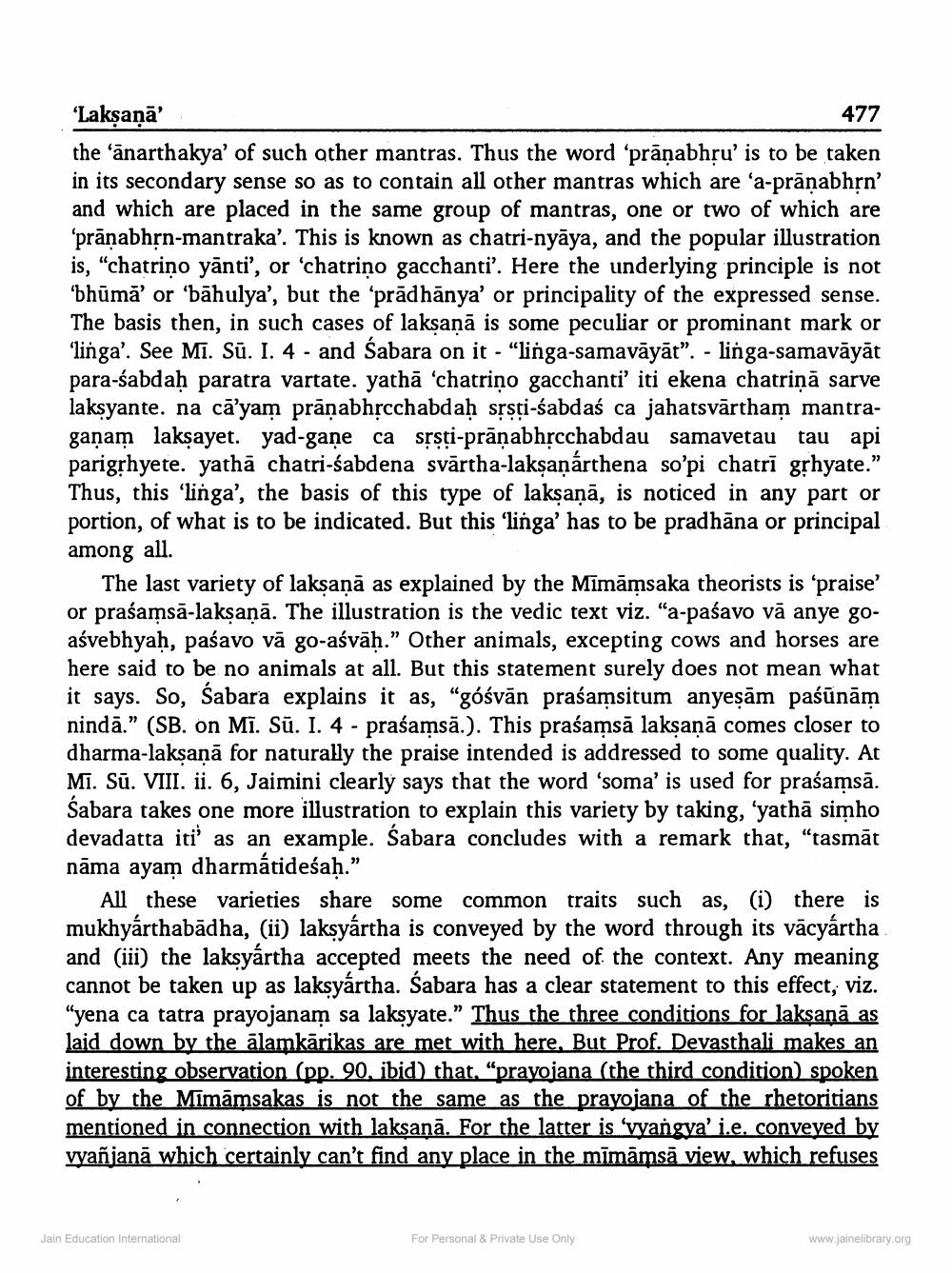________________
'Lakşaņā
477 the 'ānarthakya' of such other mantras. Thus the word 'prānabhru' is to be taken in its secondary sense so as to contain all other mantras which are 'a-prānabhỉn' and which are placed in the same group of mantras, one or two of which are 'prānabhrn-mantraka'. This is known as chatri-nyāya, and the popular illustration is, "chatrino yānti', or 'chatrino gacchanti'. Here the underlying principle is not 'bhūmā' or 'bāhulya', but the 'prādhānya' or principality of the expressed sense. The basis then, in such cases of laksanā is some peculiar or prominant mark or 'linga'. See Mi. Sū. I. 4 - and Sabara on it - "linga-samavāyāt". - linga-samavāyāt para-sabdaḥ paratra vartate. yathā 'chatriņo gacchanti' iti ekena chatriņā sarve laksyante. na cā’yam prāṇabhrcchabdaḥ sșsti-sabdaś ca jahatsvārtham mantraganam laksayet. yad-gane ca srsti-prāṇabhrcchabdau samavetau tau api parigrhyete. yathā chatri-sabdena svārtha-laksanárthena so'pi chatrī grhyate.” Thus, this 'linga', the basis of this type of laksanā, is noticed in any part or portion, of what is to be indicated. But this ‘linga' has to be pradhāna or principal among all.
The last variety of laksana as explained by the Mimāmsaka theorists is 'praise' or praśamsā-laksanā. The illustration is the vedic text viz. "a-paśavo vā anye goaśvebhyah, paśavo vā go-aśvāḥ.” Other animals, excepting cows and horses are here said to be no animals at all. But this statement surely does not mean what it says. So, sabara explains it as, “góśvān praśamsitum anyeşām paśūnām nindā." (SB. on Mi. Sū. I. 4 - praśamsā.). This praśamsā laksanā comes closer to dharma-laksanā for naturally the praise intended is addressed to some quality. At Mi. Sū. VIII. ii. 6, Jaimini clearly says that the word 'soma' is used for praśamsā. Sabara takes one more illustration to explain this variety by taking, 'yathā simho devadatta iti' as an example. Sabara concludes with a remark that, “tasmāt nāma ayam dharmátideśaḥ.”
All these varieties share some common traits such as, (i) there is mukhyárthabādha, (ii) laksyártha is conveyed by the word through its vācyártha and (iii) the laksyártha accepted meets the need of the context. Any meaning cannot be taken up as laksyártha. Sabara has a clear statement to this effect, viz. "yena ca tatra prayojanam sa laksyate." Thus the three conditions for laksanā as laid down by the alamkārikas are met with here. But Prof. Devasthali makes an interesting observation (pp. 90. ibid) that, “prayojana (the third condition) spoken of by the Mimāmsakas is not the same as the prayojana of the rhetoritians mentioned in connection with laksanā. For the latter is 'wanga' i.e. conveyed by wanjan, which certainly can't find any place in the mīmāmsā view. which refuses
Jain Education International
For Personal & Private Use Only
www.jainelibrary.org




